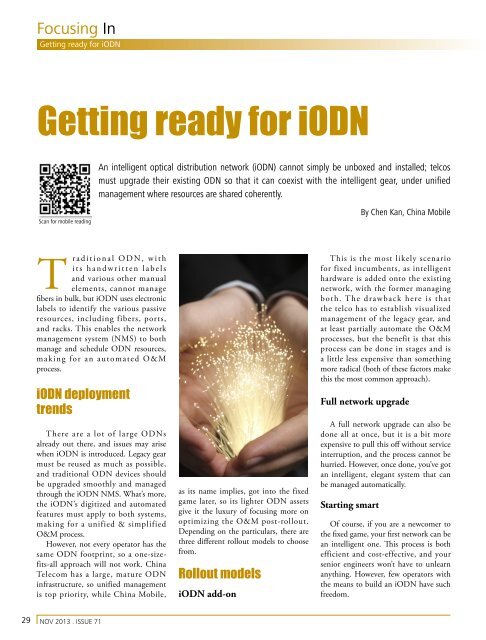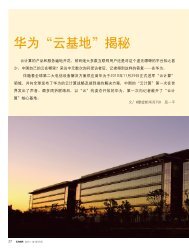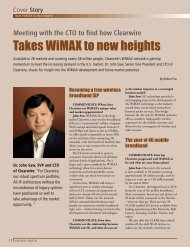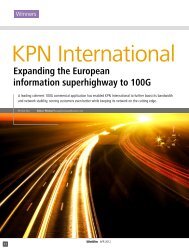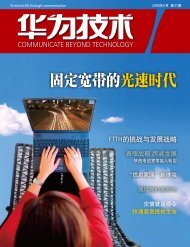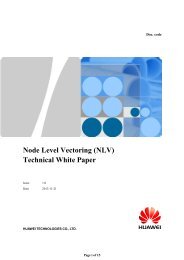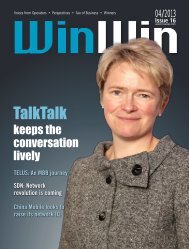Download - Huawei
Download - Huawei
Download - Huawei
You also want an ePaper? Increase the reach of your titles
YUMPU automatically turns print PDFs into web optimized ePapers that Google loves.
Focusing In<br />
Getting ready for iODN<br />
Getting ready for iODN<br />
An intelligent optical distribution network (iODN) cannot simply be unboxed and installed; telcos<br />
must upgrade their existing ODN so that it can coexist with the intelligent gear, under unified<br />
management where resources are shared coherently.<br />
Scan for mobile reading<br />
By Chen Kan, China Mobile<br />
Traditional ODN, with<br />
its handwritten labels<br />
and various other manual<br />
elements, cannot manage<br />
fibers in bulk, but iODN uses electronic<br />
labels to identify the various passive<br />
resources, including fibers, ports,<br />
and racks. This enables the network<br />
management system (NMS) to both<br />
manage and schedule ODN resources,<br />
making for an automated O&M<br />
process.<br />
iODN deployment<br />
trends<br />
There are a lot of large ODNs<br />
already out there, and issues may arise<br />
when iODN is introduced. Legacy gear<br />
must be reused as much as possible,<br />
and traditional ODN devices should<br />
be upgraded smoothly and managed<br />
through the iODN NMS. What’s more,<br />
the iODN’s digitized and automated<br />
features must apply to both systems,<br />
making for a unified & simplified<br />
O&M process.<br />
However, not every operator has the<br />
same ODN footprint, so a one-sizefits-all<br />
approach will not work. China<br />
Telecom has a large, mature ODN<br />
infrastructure, so unified management<br />
is top priority, while China Mobile,<br />
as its name implies, got into the fixed<br />
game later, so its lighter ODN assets<br />
give it the luxury of focusing more on<br />
optimizing the O&M post-rollout.<br />
Depending on the particulars, there are<br />
three different rollout models to choose<br />
from.<br />
Rollout models<br />
iODN add-on<br />
This is the most likely scenario<br />
for fixed incumbents, as intelligent<br />
hardware is added onto the existing<br />
network, with the former managing<br />
both. The drawback here is that<br />
the telco has to establish visualized<br />
management of the legacy gear, and<br />
at least partially automate the O&M<br />
processes, but the benefit is that this<br />
process can be done in stages and is<br />
a little less expensive than something<br />
more radical (both of these factors make<br />
this the most common approach).<br />
Full network upgrade<br />
A full network upgrade can also be<br />
done all at once, but it is a bit more<br />
expensive to pull this off without service<br />
interruption, and the process cannot be<br />
hurried. However, once done, you’ve got<br />
an intelligent, elegant system that can<br />
be managed automatically.<br />
Starting smart<br />
Of course, if you are a newcomer to<br />
the fixed game, your first network can be<br />
an intelligent one. This process is both<br />
efficient and cost-effective, and your<br />
senior engineers won’t have to unlearn<br />
anything. However, few operators with<br />
the means to build an iODN have such<br />
freedom.<br />
29<br />
NOV 2013 . ISSUE 71
<strong>Huawei</strong> Communicate<br />
A three-step rollout<br />
Step 1: Cable distribution<br />
The cable distribution layer consists of optical<br />
cross-connections that involve a large number of<br />
devices. China Mobile purchased 125,000 fiber<br />
distribution terminals (FDTs) in 2012 alone.<br />
Traditional ODN uses paper labels to identify<br />
ports that engineers must manually record into<br />
the resource management system – an errorprone<br />
process. What’s more, monitoring cable<br />
distribution device rollout is difficult as most<br />
deployment is done outdoors, and this can lead to<br />
resource waste, engineering error, and slow network<br />
rollout. Thus, introducing intelligence to the cable<br />
distribution layer is prioritized.<br />
Step 2: Metro backbone<br />
The core convergence layer is an upper network<br />
layer that transmits bulk service data; it consists of<br />
optical main distribution frames (MDFs), housed<br />
in equipment rooms, and engineers must confirm<br />
and check MDF connections during routine<br />
maintenance, ensuring precise resource data input.<br />
In China, telcos have mature fiber infrastructure<br />
for the core convergence layers on their metro<br />
backbones, and iODN would be preferred for<br />
new, modest projects or network expansions. As<br />
the convergence layer handles traffic in bulk, and<br />
requires high reliability, telcos should upgrade<br />
their fiber access network first, before introducing<br />
iODN to the convergence layer.<br />
Step 3: Last-mile access<br />
Terminal gear includes millions of smallcapacity<br />
(16- or 32-core) optical splitter boxes,<br />
and this makes iODN introduction a tremendous<br />
investment. Therefore, telcos need to implement<br />
an iODN strategy in phases, based on actual<br />
service needs and not abstract principles related to<br />
engineering or elegance.<br />
Resource management<br />
tactics<br />
For modest iODN additions, telcos need to<br />
record legacy ODN device information into the<br />
NMS, which can be used in electronic workflows<br />
that enhance O&M efficiency. As both the ODN<br />
and iODN will use a unified platform, telcos can<br />
deliver electronic O&M work orders, with manual<br />
operations needed solely for onsite engineering and<br />
resource/order confirmation. After the work onsite<br />
is finished, engineers send the results to the NMS<br />
through handheld terminals.<br />
For full network upgrade to iODN, telcos need<br />
to check all fiber ports and types of services running<br />
on the optical fiber before network upgrade. After<br />
the upgrade, the NMS can automatically obtain<br />
the data from fiber jumpers, facilitating project<br />
implementation and optical resource maintenance.<br />
With iODN, telcos need not manually enter<br />
network resource data, inquire about port status,<br />
or print paper labels, making for a vastly improved<br />
process.<br />
For new iODN rollouts, telcos can automatically<br />
and correctly record network resource data for<br />
various elements, including the fiber ports,<br />
ensuring efficient project implementation and<br />
O&M.<br />
Key rollout requirements<br />
Network resource survey is key to an iODN<br />
upgrade, and only a completely new iODN rollout<br />
can go without one, as port/resource data collection<br />
and fiber path scheduling are done automatically.<br />
Compatible hardware is also required if an<br />
ODN upgrade is to maximize legacy resource<br />
usage. The ODN devices should have sufficient<br />
space for installing intelligent components,<br />
including the backplanes, management modules,<br />
and slide-park modules, so the dimensions for<br />
these components must be standard. In addition,<br />
electronic labels should be added for pigtails,<br />
without service interruption. Other components<br />
such as service boards, subracks, and optical fiber<br />
routing should also support upgrades.<br />
Traditional ODNs have mature O&M flows<br />
that may not suit iODN. If ODN and iODN<br />
O&M processes are separate, management costs<br />
will go up. Only an ODN network with unified<br />
management, O&M processes, and resource<br />
allocation can smoothly support service growth.<br />
However, a powerful NMS is needed here, and<br />
traditional ODNs should be upgraded to support<br />
management display and electronic work orders,<br />
while supporting real-time data check, jointly with<br />
NMS.<br />
Editor: Michael huangzhuojian@huawei.com<br />
NOV 2013 . ISSUE 71<br />
30


